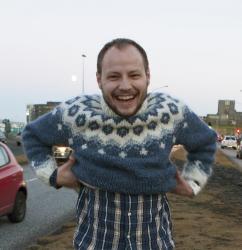
'The Haunting of Reykjavík' by Steinar Bragi
Despite its late-night silence, eerie for a city of its size, most would not consider Reykjavík a particularly spooky place. One might be hard-pressed to argue otherwise, but novelist Steinar Bragi has certainly tried with his collection of Icelandic ghost stories, ‘The Haunting of Reykjavík.’
Most of the writing in the book is well-wrought, delivering the information with some style. However, the material often seems stretched as thin as the book itself, containing just a few solid stories altogether. Most stories, while enlaced in the interesting specifics of their identifiable location, are your typical horror archetypes: a person possibly died there and the furniture moves itself now; in a dream, someone sees specific details they couldn’t possibly guess; women in white dresses are forever looking for their children; and so on.
Almost of more interest than the paranormal activity are the histories of buildings, places, and characters that tie the stories to Reykjavík. Did you know there was an outbreak of typhoid in Reykjavík in 1906, likely due to human waste used as fertilizer? How about that the former home of iconic poet Jónas Hallgrímsson is now the café at the Árbær Open Air Museum? You do now.
The book is designed in an attempt to enhance its spookiness. Each page is laid out with sepia-toned illustrations of dark corridors, the silhouettes of dead trees, and crumbling walls. While the overall effect of the page design works well in terms of vibe and pacing, many images crumble under scrutiny. There are pencil drawings whose cartoony style and quality make a joke of scenes depicted. Many photos are spoiled by modern details like new cars and the giant letter ‘i’ of tourist information centres on Laugavegur, making some pages look like they were ripped from a tourist’s Instagram account.
The book’s best quality is the fact that it was written by Steinar Bragi, who managed not to take it too seriously. His sense of humour shows through like a ghost through a mirror. In describing a haunting at Höfði, the house where Gorbachev met Reagan to discuss nuclear disarmament, he casually claims that the “greatest outcome of the summit was that it led to the single ‘Einn mol’á mann’ by The Sugarcubes being financed” and therefore Björk’s subsequent fame.
In between drowned babies and faceless heads, he also makes sure to include silly ghosts. One haunting is simply the persistent smell of human faeces where a contaminated well once stood (and indeed the design on these pages includes poo splatters). Another is the ghost of a wealthy but generous businessman who allows any invoker of his name to roll a perfect hand of the dice when playing Yahtzee. He is also kind enough to give explicit directions on how to catch glimpses of certain spirits around town. He even offers the ghosts consolation at times, ending the chapter on a ghost trapped in a public bathroom: “Look into the light, man!”
So if you’re looking for a good chuckle, want to hunt for ghosts this October, or need supernatural assistance to beat your co-workers at board games—voilà.
Buy subscriptions, t-shirts and more from our shop right here!















